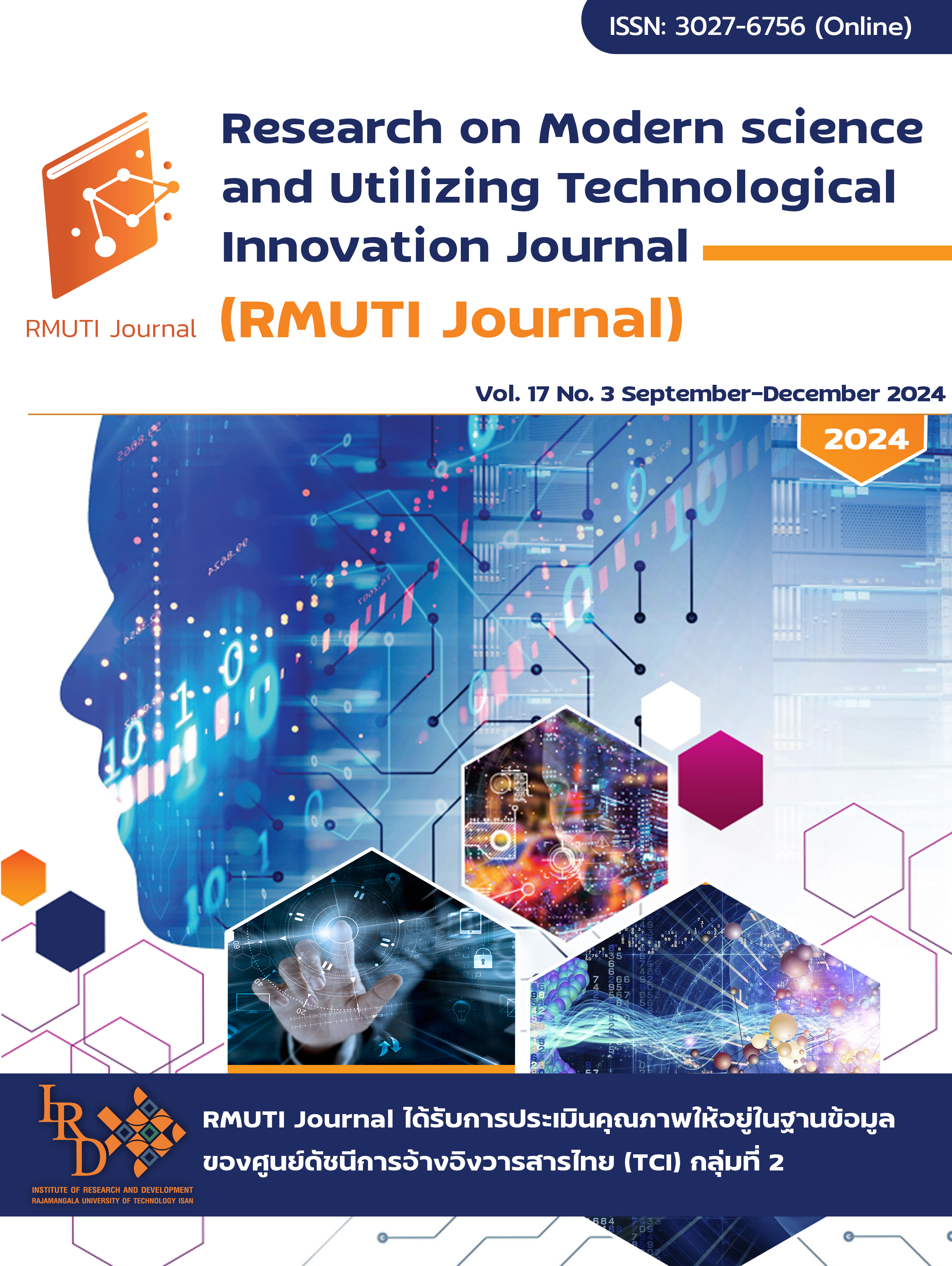Production of Resistant Starch from Legume Flour by Co-Fermentation and Using Pullulanase and Retrogradation
Main Article Content
Abstract
This research aimed to investigate the effect of fermentation and using pullulanase and retrogradation time on resistant starch (RS) content and properties of legume flour. The legume flours (mung bean, red kidney bean and soybean) were naturally fermented for 1 day and the fermented legume flours were debranched by hydrolyze the -1,6-Glycosidic Linkages by pullulanase (40 U/g) at 50 oC for 12 24 36 and 48 hours. The optimal incubation time with high degree of pullulanase hydrolysis was 24 hours. The fermented debranched flours were then induced at 4 oC for 1 3 5 7 and 14 days. The results showed that the optimum retrogradation time was 14 days with high RS content. The modified resistant starch was analyzed its granule structure by Scanning Electron Microscope (SEM) and showed that there was not found the granule starch with an irregular shape. The crystalline structure of the modified resistant starch by X-Ray diffractometer (XRD) showed that all 3 kinds of legumes were A-type patterns. It was found from this study that the process used to modify the starch can increase the RS content with the different granule structure and crystalline structure, resulting in a variety of resistant starch that could be applied as food ingredients in healthy foods.
Article Details

This work is licensed under a Creative Commons Attribution-NonCommercial-NoDerivatives 4.0 International License.
References
Punbusayakul, N. (1999). Utilization of Defatted Soy Flour For Partial Replacing of Wheat Flour Chiffon Cake. Food. Vol. 29, No. 3, pp. 180-186 (in Thai)
Wianggwalai, H. and Phuwong, K. (2018). Effect of Red Bean Flour Substituted for Wheat Flour on Physicochemical Properties and Free Radical Scavenging Activities in Steamed Bun (Mantou). Thai Journal of Science and Technology. Vol. 7, Supplement 5, pp. 534-543. (in Thai) DOI: 10.14456/tjst.2018.48
Boonkong, J. (2011). Resistant Starch. Journal of Food Technology, Siam University. Vol. 6, No. 1, pp. 1-8 (in Thai)
Phrukwiwattanakul, P. (2013). Production of Resistant Starch from Different Types of Starch and Determination of Their Prebiotic Properties. Master Degree of Science in Food Technology, Prince of Songkla University (in Thai)
Udomrati, S., Satmalee, P., and Surojanametakul, V. (2015). Production of Resistant Starch from Rice Flour by Fermentation and Hydrothermal Treatment. KKU Science Journal. Vol. 43, No. 2, pp. 232-248 (in Thai)
Rattanasuwan, S. and Chotineeranat, S. (2018). Effect of Production Resistant Starch by Using Pullulanase Enzyme and Retrogradation with Heat-Moisture Treatment on Legume Starch. Phranakhon Rajabhat Research Journal: Science and Technology. Vol. 13, No. 2, pp. 133-145 (in Thai)
Shin, S., Byun, J., Park, K. H., and Moon, T. W. (2004). Effect of Partial Acid Hydrolysis and Heat-Moisture Treatment on Formation of Resistant Tuber Starch. Cereal Chemistry. Vol. 81, No. 2, pp. 194-198. DOI: 10.1094/CCHEM.2004.81.2.194
Juliano, B. O. (1971). A Simplified Assay for Milled Rice Amylose. Cereal Science Today. Vol. 16, No. 10, pp. 334-338
Miller, G. (1959). Use of Dinitrosalicylic Acid Reagent for Determination of Reducing Sugars. Analytical Chemistry. Vol. 31, No. 3, pp. 426-428. DOI: 10.1021/ac60147a030
Dubois, M., Gilles, K. A., Hamitton, J. K., Rebers, P. A., and Smith, F. (1956). Colorimetric Method For Determination of Sugars and Related Substances. Analytical Chemistry. Vol. 28, No. 3, pp. 350-356. DOI: 10.1021/ac60111a017
AOAC. (2000). Official Methods of Analysis Association of Official Analytical Chemist. Washington D.C.
Granito, M. and Álvarez, G. (2006). Lactic Acid Fermentation of Black Bean (Phaseolus Vulgaris): Microbiological and Chemical Characterization. Journal of the Science of Food and Agriculture. Vol. 86, pp. 1164-1171. DOI: 10.1002/jsfa.2490
Yadav, B. S., Sharma, A., and Yadav, R. B. (2007). Study of Effect of Natural Fermentation on The Resistant Starch Content of Legume Based Fermented Foods. Journal of Agricultural Technology. Vol. 3, No. 1, pp. 21-27
Setiarto, R. H. B., Jenie, B. S. L., Faridah, D. N., Sakiawan, I., and Sulistiani. (2018). Effect of Lactic Acid Bacteria Fermentation and Autoclaving-Cooling for Resistant Starch and Prebiotic Properties of Modified Taro Flour. International Food Research Journal. Vol. 25, No. 4, pp. 1691-1697
Pongjanta, J., Utaipatanacheep, A., Naivikul, O., and Piyachomkwan, K. (2008). Enzymes-Resistant Starch (RS III) from Pullulanase-Debranched High Amylose Rice Starch. Agricultural and Natural Resources. Vol. 42, No. 5, pp. 198-205
González-Soto, R. A., Agama-Acevedo, E., Solorza-Feria, J., Rendón-Villalobos, R., and Bello-Pérez, L. A. (2004). Resistant Starch Made from Banana Starch by Autoclaving and Debranching. Starch. Vol. 56, Issue 10, pp. 495-49. DOI: 10.1002/star.200400283
Polesi, L. E. and Sarmento, S. B. S. (2011). Structural and Physicochemical Characterization of RS Prepared Using Hydrolysis and Heat Treatments of Chickpea Starch. Starch. Vol. 63, Issue 4, pp. 226-235. DOI: 10.1002/star.201000114
Chatpapamon, C., Puncha-arnon, S., and Uttapap, D. (2016). Effect of Heat-moisture Treatment on Properties and Structure of A- and B-crystalline Type Starches. KMUTT Research and Development Journal. Vol. 39, No. 2, pp. 257-270 (in Thai)
Shi, M., Chen, Y., Yu, S., and Gao, Q. (2013). Preparation and Properties of RS III from Waxy Maize Starch with Pullulanase. Food Hydrocolloids. Vol. 33, Issue 1, pp. 19-25. DOI: 10.1016/j.foodhyd.2013.02.018
Gunaratne, A. and Hoover, R. (2002). Effect of Heat-Moisture Treatment on The Structure and Physicochemical Properties of Tuber and Root Starches. Carbohydrate Polymers. Vol. 49, Issue 4, pp. 425-437. DOI: 10.1016/S0144-8617(01)00354-X


